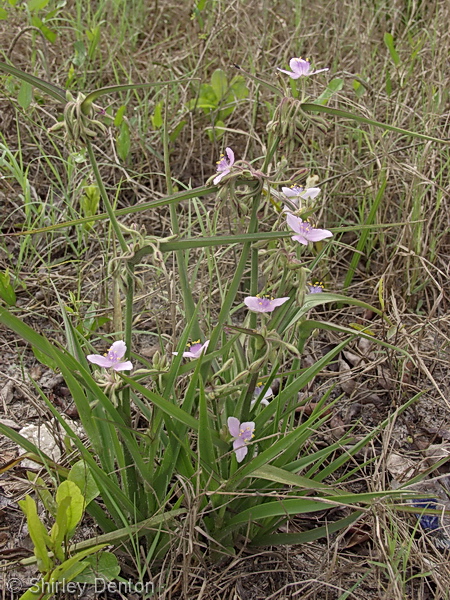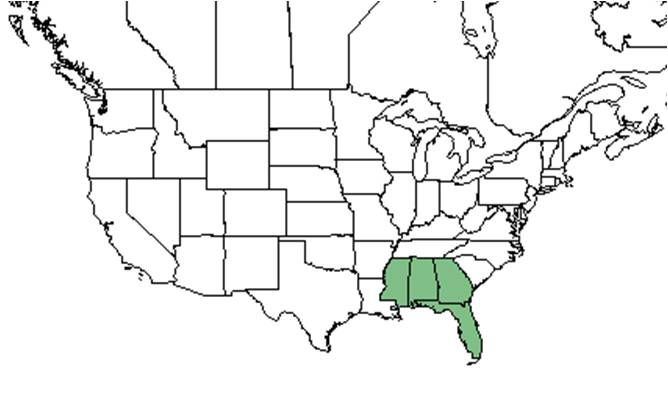Difference between revisions of "Tradescantia roseolens"
Krobertson (talk | contribs) (→Description) |
Krobertson (talk | contribs) (→Distribution) |
||
| Line 31: | Line 31: | ||
==Distribution== | ==Distribution== | ||
| − | Alabama, Florida, Georgia, and South Carolina. It is listed as imperiled in Georgia<ref name="natureserve">[[http://explorer.natureserve.org/servlet/NatureServe?searchName=Tradescantia+roseolens]]NatureServe. Accessed: March 21, 2016</ref> | + | Alabama, Florida, Georgia, and South Carolina. It is listed as imperiled in Georgia.<ref name="natureserve">[[http://explorer.natureserve.org/servlet/NatureServe?searchName=Tradescantia+roseolens]]NatureServe. Accessed: March 21, 2016</ref> |
==Ecology== | ==Ecology== | ||
Revision as of 18:46, 18 August 2016
| Tradescantia roseolens | |
|---|---|

| |
| Photo by Shirley Denton (Copyrighted, use by photographer’s permission only), Nature Photography by Shirley Denton | |
| Scientific classification | |
| Kingdom: | Plantae |
| Division: | Magnoliophyta - Flowering plants |
| Class: | Liliopsida – Monocotyledons |
| Order: | Commelinales |
| Family: | Commelinaceae |
| Genus: | Tradescantia |
| Species: | T. roseolens |
| Binomial name | |
| Tradescantia roseolens Small | |

| |
| Natural range of Tradescantia roseolens from USDA NRCS Plants Database. | |
Common name: longleaf spiderwort
Contents
Taxonomic notes
Synonym: Tradescantia longifolia Small
The specific epithet roseolens is derived from the fragrant tea-rose smell emitted from the flower.[1]
Description
A description of Tradescantia roseolens is provided in The Flora of North America.
T. roseolens is similar to T. longifolia; however, T. roseolens can be differentiated by having smaller fragrant flowers and glandless stems.[1]
Distribution
Alabama, Florida, Georgia, and South Carolina. It is listed as imperiled in Georgia.[2]
Ecology
Habitat
Habitats of T. roseolens include Florida rosemary balds, oak scrubs, hammocks, sandhills, pinewoods, and roadsides[3][4]. Associated species include Ceratiola, Quercus inopina, Q. geminata and Q. chapmanii. In Florida rosemary balds, T. roseolens was found to be positively associated with patch isolation[5].
Phenology
Flowers February to August[3].
Fire ecology
Long periods of fire suppression can hinder the response of ephemeral, resprouting/seeding herbs such as T. roseolens. Fire has been observed to revitalize populations in recently burned sites[6].
Pollination
The stamens have scent-producing hairs that attract pollinators. T. roseolens has 6 pollen baring anthers, allowing several flies to feed simultaneously on one flower. Deyrup (1988) observed that P. punctipennis was the most abundant insect on T. roseolens at Archbold Biological Station.
The following Hymenoptera families and species were observed visiting flowers of Tradescantia roseolens at Archbold Biological Station: [7]
Halictidae: Lasioglossum nymphalis, L. placidensis, L. puteulanum
Conservation and management
Cultivation and restoration
Photo Gallery
References and notes
Deyrup, M. A. (1988). "Pollen-Feeding in Poecilognathus punctipennis (Diptera: Bombyliidae)." The Florida Entomologist 71(4): 597-605.
- ↑ 1.0 1.1 Small, J. K. (1924). "Plant Novelties from Florida." Bulletin of the Torrey Botanical Club 51(9): 379-393.
- ↑ [[1]]NatureServe. Accessed: March 21, 2016
- ↑ 3.0 3.1 [[2]]Encyclopedia of Life. Accessed: March 21, 2016
- ↑ Florida State University Robert K. Godfrey Herbarium database. URL: http://herbarium.bio.fsu.edu. Last accessed: November 2015. Collectors: Steven P. Christman, Robin B. Huck. States and Counties: Florida: Highlands. Compiled by Tall Timbers Research Station and Land Conservancy.
- ↑ Quintana-Ascencio, P. F. and E. S. Menges (1996). "Inferring Metapopulation Dynamics from Patch-Level Incidence of Florida of Scrub Plants." Conservation Biology 10(4): 1210-1219.
- ↑ Abrahamson, W. G. and C. R. Abrahamson (1996). "Effects of Fire on Long-Unburned Florida Uplands." Journal of Vegetation Science 7(4): 565-574.
- ↑ Deyrup, M.A. and N.D. 2015. Database of observations of Hymenoptera visitations to flowers of plants on Archbold Biological Station, Florida, USA.